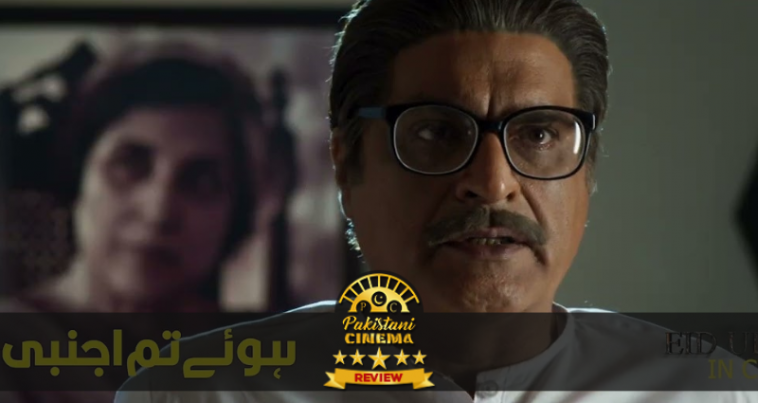After so many delays, Kamran Shahid’s film “Huey Tum Ajnabi” has finally released in theatres on Eid-ul-Fitr. During the promotional campaign, Kamran kept reiterating that this one is his unbiased take on true events of Fall of Dhaka and also that it’s not a historical drama rather it’s about a love story set in the same time period of 1970’s and how those events affected the lives of the lead characters. However, Kamran’s statements do not hold true as the film, throughout its runtime, presents one sided perspective so passionately that it leaves you wonder whether it’s truly an independent film. However, presenting one sided distorted history isn’t the only thing that goes wrong about the film.
Absurd Story with a Dis-jointed Screenplay
The film lacks a sound plot and attempts to narrate two parallel tracks; one of lead characters “Zeenat” (played by Sadia Khan) and “Nizam-uddin” (played by Mikaal Zulfiqar) and the other track is that of events happening on state-level between India, West Pakistan and East Pakistan. The film moves between the romantic track and the historical drama in a most bizarre way. The story is all over the place and the screenplay is extremely incoherent. This could also be due to the haphazard editing to cut down the original length as so much is missing in the narrative. The 90’s Lollywood star Resham was also a part of this project but she is not there in the final released version. Similarly, Ayesha Omar who was supposed to play the role of a journalist, never gets to establish that her role is that of a journalist as in the final version she is just there among many others held captives in Bangladesh.
Another Ridiculous Attempt to Distort History
The film also distorts history in a very ridiculous manner. But since the whole film is so absurd that you are not really bothered with this one-sided narrative. The filmmaker chooses not to discuss what has been brewing in East Pakistan all along that finally led to the rebellion by Bengalis against the state; it rather simply portrays the rebels as puppets of Indian agenda. It also brushes under the carpet the atrocities that Punjabis dominated Pakistan army committed on its own people in East Pakistan. The film only features the characters of Indira Gandhi and Mujib ur Rehman while Zulfiqar Ali Bhutto’s role is reduced to just one scene and guess what? there is no General Yahya Khan anywhere.
Amateur Direction and Cheap Production
The film is set mostly in East Pakistan but characters do not speak Bengali. Everyone in Dhaka university is shown speaking Urdu without any Bengali dialect. Even a courtesan in Dhaka sings Jaun Elia’s “Kis say Izhar e Muddah Kijiye”, a fine Urdu poem in a Bengali brothel. This is no more 90’s when even British officers were shown speaking in Urdu or Hindi to facilitate an average cinegoer. They could have shown Bengalis exchanging some dialogues in their own language while facilitating the audience with Urdu subtitles.
The production is tacky too. Shafqat Cheema, who is shown playing a man of fortune in Punjab, wears a cheap Sherwani which is also later re-used by a side character in a scene outside Lahori brothel. Similarly, a statue of Hindu Goddess Kali is also used in two different scenes (once inside the brothel in Bengal and later outside the same brothel) to make the most out of the given props. The wardrobe is cheap with lead actress Sadia Khan wearing mostly synthetic Jamawar in mujra numbers. Her styling too doesn’t reflect the era. Kamran could have taken a cue on wardrobe and styling from Hassan Tariq’s films from late 60’s and early 70’s like “Anjuman” and “Umrao Jaan Ada”, the later also starred Kamran’s father Shaahid in lead.
Shamelessly Playing Religion Card
Just like politics, here in film medium too they have chosen to play religion card. A bunch of captive girls in a critical scene start singing and dancing on “Tajdaar e Haram” and guess what? It does miracles. Although such tactics have always been employed in films from Lollywood era that mainly catered single screen audiences, but using religion card to induce emotions in your Muslim majority audience and to justify the miraculous stunts of Muslim characters against antagonists of a different faith and culture is the most shameless thing a filmmaker can do in today’s age.
Horrendous Music that Adds No Value
Film has numerous forcefully added songs that add no value to the already shallow narrative. Except for one song by Abida Parveen, the songs of the film are simply plain bad and forgettable. They even ruined popular classics like “Rashk e Qamar” and “Tajdaar e Haram”. The background music is loud and distracting throughout and makes the already poorly executed drama scenes even more unbearable.
Loads and Loads of Overacting
It’s a shame that a film that features actors like Samina Peerzada, Mehmood Aslam, Aly Khan lacks in acting. All actors, juniors or veterans, give over the top performances. It even gets to cringe-inducing levels when coupled with bad writing. Sohail Ahmed however manages to be the only actor to somewhat shine in the given role.
What Works?
There is a considerable amount of effort that went into creating the two sets of brothels. In the brothel that is shown to be in Lahore, there are paintings of Mughal era courtesans on walls. The brothel in Dhaka has a different character to it through different colours and set designing, setting it apart from the one shown to be in Lahore. Both these Kothaa sets are the most elaborate ones we have seen in revived cinema, a lot better than what we have seen in “Mah e Mir”. The VFX are good too and some war scenes can really get you hooked for a few good seconds.
Verdict
If you are planning to watch the film hoping for it to deal with the 1971 tragedy in a sensitive and insightful manner, you will be disappointed big time. But if you have a thing for 90’s and early 20’s flavour of Lollywood and if some sleazy mujra numbers and a few well executed war scenes can make you sit through a 2 hour 40 minutes (approximately) long film, go for it.



Comments
Loading…
Comments
0 comments